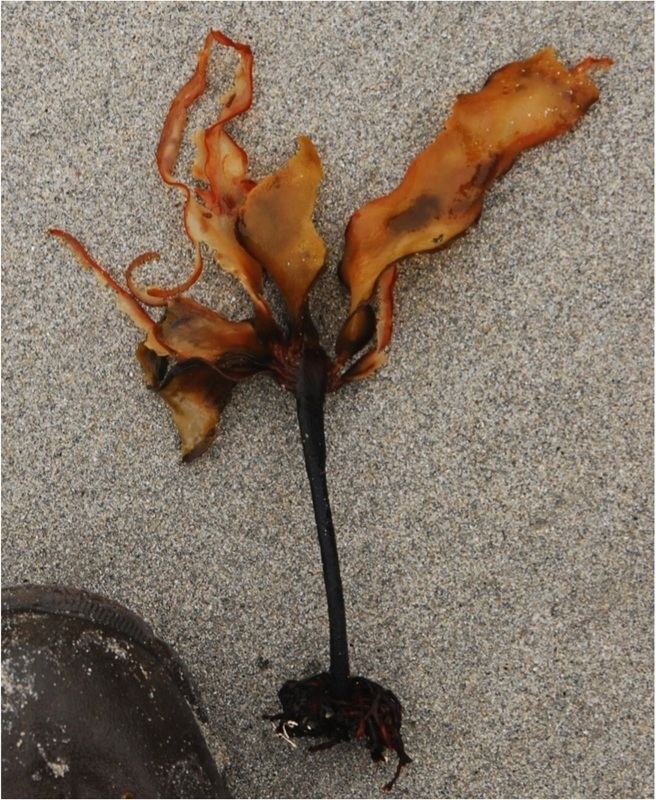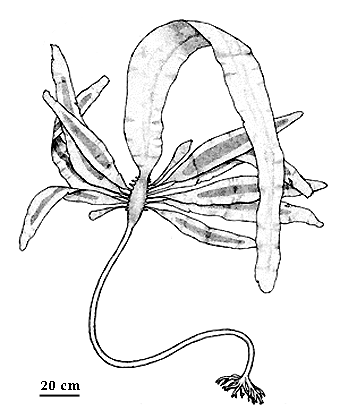Superphylum Heterokonta Family Alariaceae Rank Genus | Class Phaeophyceae Species P. californica Order Kelp | |
 | ||
Similar Kelp, Nereocystis, Eisenia arborea, Eisenia, Alaria marginata | ||
Pterygophora californica is a large species of kelp, commonly known as stalked kelp. It is the only species in its genus Pterygophora (Ruprecht, 1852). It grows in shallow water on the Pacific coast of North America where it forms part of a biodiverse community in a "kelp forest".
Contents

Description

P. californica is a large brown seaweed and may grow to about three metres in height. It is attached to a rocky substrate by its holdfast and has a single, tough, woody stipe or stem up to two metres long and 2 cm (0.8 in) in diameter. It is a long-lived perennial plant which may survive for twenty-five years, and annual growth rings can be seen in the stipe. There are a number of smooth blades arranged on either side of the top half of the stipe. These are sporophylls and bear reproductive organs called sporangia in which the spores are formed. The terminal blade is linear, has a midrib and is larger than the others, growing up to 90 cm (33 in) long.
Distribution
P. californica is found in the sublittoral zone of the west coast of North America from British Columbia south to Mexico at depths down to about ten metres.
Biology

Reproduction in P. californica involves an alternation of generations. Microscopic zoospores are produced in the sporangia. After release, these settle on the sea bed and develop into haploid gametophytes. These produce male and female gametes the fertilisation of which results in zygote formation and the growth of the diploid sporophytes, the stipe and blades.
Ecology

P. californica grows in underwater kelp forests with other brown algae including the annual species, bull kelp (Nereocystis luetkeana) and giant kelp (Macrocystis pyrifera). Brown seaweeds are photosynthetic organisms and their growth is mainly restricted by the availability of light. Various algae try to get a head start by attaching themselves to P. californica well above the ocean floor. These include red algae (Rhodophyte spp.), bull kelp (Nereocystis luetkeana) and sea belt (Saccharina latissima). The most common cause of death of P. californica is being torn from the rocks during storms. This is made more likely by the drag caused by the epiphyte burden. P. californica and other Laminariales attempt to reduce their epiphytic load by periodically sloughing off their surface layers and by the production of "antifouling" substances such as phenols in their tissues.

At Race Rocks, near Vancouver Island, it was found that during the winter, the only remains of the kelp forest was the bare stipes of P. californica, the annual seaweeds having been broken down and dispersed. By mid summer however, the fast-growing N. luetkeana formed the canopy while P. californica and S. latissima formed a middle storey layer. In a research study in that location, it was found that much of the N. luetkeana was growing epiphytically on P. californica with their holdfasts attached to the blades and upper portions of the stipes. S latissima was also epiphytic but occupied the middle part of the stipe. Neither was present on the lower regions of the stipe and it was thought that this was due to grazing pressure from benthic macrofauna such as sea urchins.
Herbivores feed on P. californica and other kelps, the predominant grazers being sea urchins. If the population size of these becomes too great, "barren grounds", with no large algal species, can develop and may remain in existence for years. A reduction in the number of predators or a diminution in the quantity of drift algae may encourage hungry urchins to overexploit and potentially eradicate the kelp. The sea urchins Strongylocentrotus purpuratus and Strongylocentrotus droebachiensis graze on P. californica at the northern end of its range.
